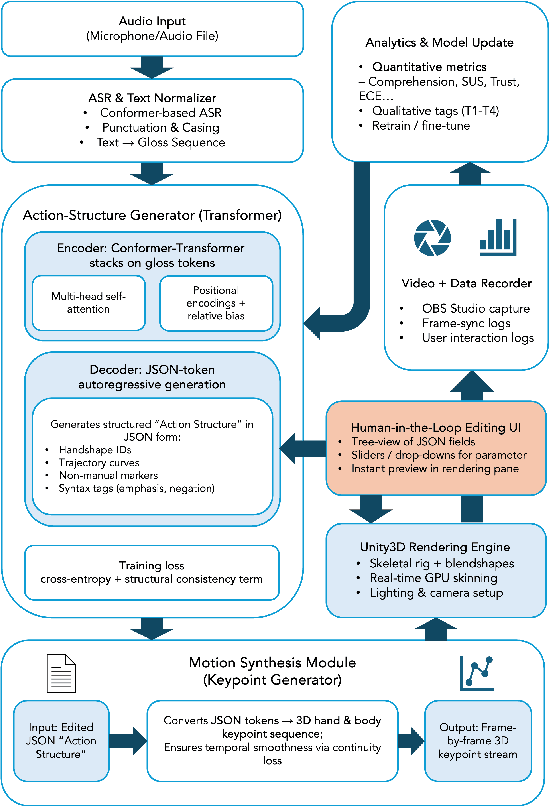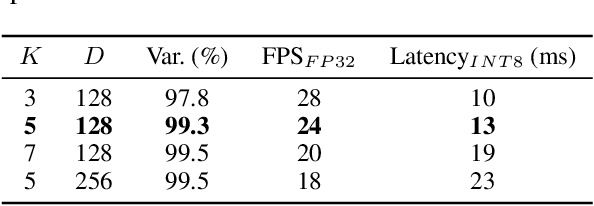Facial Editing
Papers and Code
MAGIC-Talk: Motion-aware Audio-Driven Talking Face Generation with Customizable Identity Control
Oct 26, 2025Audio-driven talking face generation has gained significant attention for applications in digital media and virtual avatars. While recent methods improve audio-lip synchronization, they often struggle with temporal consistency, identity preservation, and customization, especially in long video generation. To address these issues, we propose MAGIC-Talk, a one-shot diffusion-based framework for customizable and temporally stable talking face generation. MAGIC-Talk consists of ReferenceNet, which preserves identity and enables fine-grained facial editing via text prompts, and AnimateNet, which enhances motion coherence using structured motion priors. Unlike previous methods requiring multiple reference images or fine-tuning, MAGIC-Talk maintains identity from a single image while ensuring smooth transitions across frames. Additionally, a progressive latent fusion strategy is introduced to improve long-form video quality by reducing motion inconsistencies and flickering. Extensive experiments demonstrate that MAGIC-Talk outperforms state-of-the-art methods in visual quality, identity preservation, and synchronization accuracy, offering a robust solution for talking face generation.
ID-Consistent, Precise Expression Generation with Blendshape-Guided Diffusion
Oct 06, 2025Human-centric generative models designed for AI-driven storytelling must bring together two core capabilities: identity consistency and precise control over human performance. While recent diffusion-based approaches have made significant progress in maintaining facial identity, achieving fine-grained expression control without compromising identity remains challenging. In this work, we present a diffusion-based framework that faithfully reimagines any subject under any particular facial expression. Building on an ID-consistent face foundation model, we adopt a compositional design featuring an expression cross-attention module guided by FLAME blendshape parameters for explicit control. Trained on a diverse mixture of image and video data rich in expressive variation, our adapter generalizes beyond basic emotions to subtle micro-expressions and expressive transitions, overlooked by prior works. In addition, a pluggable Reference Adapter enables expression editing in real images by transferring the appearance from a reference frame during synthesis. Extensive quantitative and qualitative evaluations show that our model outperforms existing methods in tailored and identity-consistent expression generation. Code and models can be found at https://github.com/foivospar/Arc2Face.
InfiniteTalk: Audio-driven Video Generation for Sparse-Frame Video Dubbing
Aug 19, 2025Recent breakthroughs in video AIGC have ushered in a transformative era for audio-driven human animation. However, conventional video dubbing techniques remain constrained to mouth region editing, resulting in discordant facial expressions and body gestures that compromise viewer immersion. To overcome this limitation, we introduce sparse-frame video dubbing, a novel paradigm that strategically preserves reference keyframes to maintain identity, iconic gestures, and camera trajectories while enabling holistic, audio-synchronized full-body motion editing. Through critical analysis, we identify why naive image-to-video models fail in this task, particularly their inability to achieve adaptive conditioning. Addressing this, we propose InfiniteTalk, a streaming audio-driven generator designed for infinite-length long sequence dubbing. This architecture leverages temporal context frames for seamless inter-chunk transitions and incorporates a simple yet effective sampling strategy that optimizes control strength via fine-grained reference frame positioning. Comprehensive evaluations on HDTF, CelebV-HQ, and EMTD datasets demonstrate state-of-the-art performance. Quantitative metrics confirm superior visual realism, emotional coherence, and full-body motion synchronization.
Defending Deepfake via Texture Feature Perturbation
Aug 24, 2025The rapid development of Deepfake technology poses severe challenges to social trust and information security. While most existing detection methods primarily rely on passive analyses, due to unresolvable high-quality Deepfake contents, proactive defense has recently emerged by inserting invisible signals in advance of image editing. In this paper, we introduce a proactive Deepfake detection approach based on facial texture features. Since human eyes are more sensitive to perturbations in smooth regions, we invisibly insert perturbations within texture regions that have low perceptual saliency, applying localized perturbations to key texture regions while minimizing unwanted noise in non-textured areas. Our texture-guided perturbation framework first extracts preliminary texture features via Local Binary Patterns (LBP), and then introduces a dual-model attention strategy to generate and optimize texture perturbations. Experiments on CelebA-HQ and LFW datasets demonstrate the promising performance of our method in distorting Deepfake generation and producing obvious visual defects under multiple attack models, providing an efficient and scalable solution for proactive Deepfake detection.
LIA-X: Interpretable Latent Portrait Animator
Aug 13, 2025We introduce LIA-X, a novel interpretable portrait animator designed to transfer facial dynamics from a driving video to a source portrait with fine-grained control. LIA-X is an autoencoder that models motion transfer as a linear navigation of motion codes in latent space. Crucially, it incorporates a novel Sparse Motion Dictionary that enables the model to disentangle facial dynamics into interpretable factors. Deviating from previous 'warp-render' approaches, the interpretability of the Sparse Motion Dictionary allows LIA-X to support a highly controllable 'edit-warp-render' strategy, enabling precise manipulation of fine-grained facial semantics in the source portrait. This helps to narrow initial differences with the driving video in terms of pose and expression. Moreover, we demonstrate the scalability of LIA-X by successfully training a large-scale model with approximately 1 billion parameters on extensive datasets. Experimental results show that our proposed method outperforms previous approaches in both self-reenactment and cross-reenactment tasks across several benchmarks. Additionally, the interpretable and controllable nature of LIA-X supports practical applications such as fine-grained, user-guided image and video editing, as well as 3D-aware portrait video manipulation.
AvatarMakeup: Realistic Makeup Transfer for 3D Animatable Head Avatars
Jul 03, 2025Similar to facial beautification in real life, 3D virtual avatars require personalized customization to enhance their visual appeal, yet this area remains insufficiently explored. Although current 3D Gaussian editing methods can be adapted for facial makeup purposes, these methods fail to meet the fundamental requirements for achieving realistic makeup effects: 1) ensuring a consistent appearance during drivable expressions, 2) preserving the identity throughout the makeup process, and 3) enabling precise control over fine details. To address these, we propose a specialized 3D makeup method named AvatarMakeup, leveraging a pretrained diffusion model to transfer makeup patterns from a single reference photo of any individual. We adopt a coarse-to-fine idea to first maintain the consistent appearance and identity, and then to refine the details. In particular, the diffusion model is employed to generate makeup images as supervision. Due to the uncertainties in diffusion process, the generated images are inconsistent across different viewpoints and expressions. Therefore, we propose a Coherent Duplication method to coarsely apply makeup to the target while ensuring consistency across dynamic and multiview effects. Coherent Duplication optimizes a global UV map by recoding the averaged facial attributes among the generated makeup images. By querying the global UV map, it easily synthesizes coherent makeup guidance from arbitrary views and expressions to optimize the target avatar. Given the coarse makeup avatar, we further enhance the makeup by incorporating a Refinement Module into the diffusion model to achieve high makeup quality. Experiments demonstrate that AvatarMakeup achieves state-of-the-art makeup transfer quality and consistency throughout animation.
FaceEditTalker: Interactive Talking Head Generation with Facial Attribute Editing
May 28, 2025Recent advances in audio-driven talking head generation have achieved impressive results in lip synchronization and emotional expression. However, they largely overlook the crucial task of facial attribute editing. This capability is crucial for achieving deep personalization and expanding the range of practical applications, including user-tailored digital avatars, engaging online education content, and brand-specific digital customer service. In these key domains, the flexible adjustment of visual attributes-such as hairstyle, accessories, and subtle facial features is essential for aligning with user preferences, reflecting diverse brand identities, and adapting to varying contextual demands. In this paper, we present FaceEditTalker, a unified framework that enables controllable facial attribute manipulation while generating high-quality, audio-synchronized talking head videos. Our method consists of two key components: an image feature space editing module, which extracts semantic and detail features and allows flexible control over attributes like expression, hairstyle, and accessories; and an audio-driven video generation module, which fuses these edited features with audio-guided facial landmarks to drive a diffusion-based generator. This design ensures temporal coherence, visual fidelity, and identity preservation across frames. Extensive experiments on public datasets demonstrate that our method outperforms state-of-the-art approaches in lip-sync accuracy, video quality, and attribute controllability. Project page: https://peterfanfan.github.io/FaceEditTalker/
Design an Editable Speech-to-Sign-Language Transformer System: A Human-Centered AI Approach
Jun 17, 2025



This paper presents a human-centered, real-time, user-adaptive speech-to-sign language animation system that integrates Transformer-based motion generation with a transparent, user-editable JSON intermediate layer. The framework overcomes key limitations in prior sign language technologies by enabling direct user inspection and modification of sign segments, thus enhancing naturalness, expressiveness, and user agency. Leveraging a streaming Conformer encoder and autoregressive Transformer-MDN decoder, the system synchronizes spoken input into upper-body and facial motion for 3D avatar rendering. Edits and user ratings feed into a human-in-the-loop optimization loop for continuous improvement. Experiments with 20 deaf signers and 5 interpreters show that the editable interface and participatory feedback significantly improve comprehension, naturalness, usability, and trust, while lowering cognitive load. With sub-20 ms per-frame inference on standard hardware, the system is ready for real-time communication and education. This work illustrates how technical and participatory innovation together enable accessible, explainable, and user-adaptive AI for sign language technology.
The Aging Multiverse: Generating Condition-Aware Facial Aging Tree via Training-Free Diffusion
Jun 26, 2025We introduce the Aging Multiverse, a framework for generating multiple plausible facial aging trajectories from a single image, each conditioned on external factors such as environment, health, and lifestyle. Unlike prior methods that model aging as a single deterministic path, our approach creates an aging tree that visualizes diverse futures. To enable this, we propose a training-free diffusion-based method that balances identity preservation, age accuracy, and condition control. Our key contributions include attention mixing to modulate editing strength and a Simulated Aging Regularization strategy to stabilize edits. Extensive experiments and user studies demonstrate state-of-the-art performance across identity preservation, aging realism, and conditional alignment, outperforming existing editing and age-progression models, which often fail to account for one or more of the editing criteria. By transforming aging into a multi-dimensional, controllable, and interpretable process, our approach opens up new creative and practical avenues in digital storytelling, health education, and personalized visualization.
Video Editing for Audio-Visual Dubbing
May 29, 2025Visual dubbing, the synchronization of facial movements with new speech, is crucial for making content accessible across different languages, enabling broader global reach. However, current methods face significant limitations. Existing approaches often generate talking faces, hindering seamless integration into original scenes, or employ inpainting techniques that discard vital visual information like partial occlusions and lighting variations. This work introduces EdiDub, a novel framework that reformulates visual dubbing as a content-aware editing task. EdiDub preserves the original video context by utilizing a specialized conditioning scheme to ensure faithful and accurate modifications rather than mere copying. On multiple benchmarks, including a challenging occluded-lip dataset, EdiDub significantly improves identity preservation and synchronization. Human evaluations further confirm its superiority, achieving higher synchronization and visual naturalness scores compared to the leading methods. These results demonstrate that our content-aware editing approach outperforms traditional generation or inpainting, particularly in maintaining complex visual elements while ensuring accurate lip synchronization.
 Add to Chrome
Add to Chrome Add to Firefox
Add to Firefox Add to Edge
Add to Edge